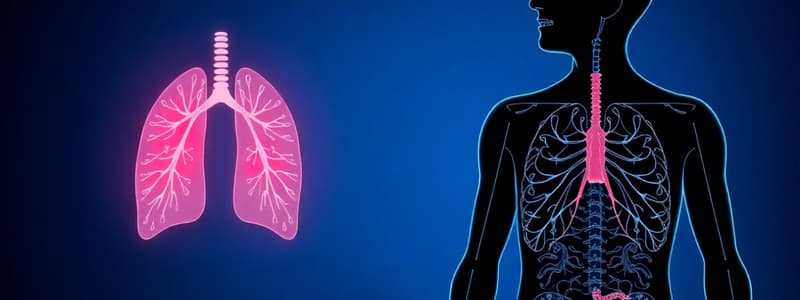Podcast
Questions and Answers
Compared to the blood entering location A in the diagram, what is different about the blood leaving the vessel network at location C?
Compared to the blood entering location A in the diagram, what is different about the blood leaving the vessel network at location C?
- It has a lower concentration of carbon dioxide. (correct)
- It has a lower concentration of oxygen and hemoglobin.
- It has a lower concentration of hemoglobin and carbon dioxide.
- It has a lower concentration of oxygen.
What are the air sacs labeled B in the diagram commonly known as?
What are the air sacs labeled B in the diagram commonly known as?
- Bronchioles
- Alveoli (correct)
- Tracheae
- Bronchi
In what form is the majority of carbon dioxide transported in the plasma?
In what form is the majority of carbon dioxide transported in the plasma?
- Oxyhemoglobin
- Bicarbonate ions (correct)
- Hydrogen ions
- Lactic acid
Which of the following circumstances would most directly lead to lactic acid production by cells in the human body?
Which of the following circumstances would most directly lead to lactic acid production by cells in the human body?
Why do humans breathe more rapidly during exercise compared to before exercise?
Why do humans breathe more rapidly during exercise compared to before exercise?
Besides water, what are the primary components of urine?
Besides water, what are the primary components of urine?
Which excretory structure forms urine from water, urea, and salts?
Which excretory structure forms urine from water, urea, and salts?
Which organ is most closely associated with the production of urea?
Which organ is most closely associated with the production of urea?
The reabsorption of materials into the capillaries surrounding the tubules of nephrons is an example of what?
The reabsorption of materials into the capillaries surrounding the tubules of nephrons is an example of what?
Which homeostatic adjustment does the human body make in response to an increase in environmental temperature?
Which homeostatic adjustment does the human body make in response to an increase in environmental temperature?
Flashcards
What are alveoli?
What are alveoli?
Tiny air sacs in the lungs where oxygen and carbon dioxide exchange occurs.
What are bicarbonate ions?
What are bicarbonate ions?
The main form in which carbon dioxide is transported in the blood plasma.
What causes lactic acid production?
What causes lactic acid production?
An insufficient oxygen supply reaching cells, leading to anaerobic respiration.
Why breathe faster during exercise?
Why breathe faster during exercise?
Signup and view all the flashcards
What is a nephron?
What is a nephron?
Signup and view all the flashcards
What is reabsorption in nephrons?
What is reabsorption in nephrons?
Signup and view all the flashcards
How to respond to high environmental temperature?
How to respond to high environmental temperature?
Signup and view all the flashcards
What is a ligament?
What is a ligament?
Signup and view all the flashcards
What is the trachea?
What is the trachea?
Signup and view all the flashcards
What is an allergy?
What is an allergy?
Signup and view all the flashcards
Study Notes
- The diagram depicts a part of the human respiratory system.
- The blood leaving the vessel network at point C has a lower concentration of oxygen compared to the blood entering at point A.
- The air sacs shown in the respiratory system diagram are alveoli.
- Most carbon dioxide is carried in the plasma in the form of bicarbonate ions.
- Lactic acid production in cells results from an insufficient amount of oxygen reaching the cells.
- Humans breathe more rapidly during exercise because the blood contains an increased level of carbon dioxide.
- Besides water, urea and salts are the main components of urine.
- The nephron is the excretory structure responsible for forming urine from water, urea, and salts.
- The kidney is closely associated with the production of urea.
- Reabsorption of materials into capillaries around nephron tubules exemplifies a homeostatic mechanism.
- The body increases perspiration production as a homeostatic adjustment to an increase in environmental temperature.
- Skeletal muscle tissue is most abundant in the foot.
- Cartilage should be present in the regions labelled A to reduce friction and increase flexibility of the human skeletal system.
- A ligament is the connective tissue joining two bones together to form a joint.
- Failure of a movable joint to function correctly may be due to damage to ligaments.
- The trachea is a respiratory structure supported by rings of cartilage.
- Deposits from cigarette smoke interfere with the action of cilia in the trachea.
- Bronchial tube constriction during an asthma attack is best described as an allergy.
- Food in the trachea will most likely interfere with the passage of air to the alveoli.
- The diagram demonstrates the breathing process, where the balloons represent lungs
- The change in the balloons occurs because the rubber sheet is pulled into the bell jar due to balloon expansion.
- Structure B on the human urinary system diagram filters urea out of the bloodstream.
- Regulation of body temperature relates to the evaporation of sweat.
- Gout patients may experience pain due to uric acid deposition in area E.
- The urethra releases urine from the urinary bladder.
- The urethra eliminates urine from the bladder.
- A ligament connects the end of one bone to another at a movable joint.
- The tough connective tissue labeled A is a tendon that anchors a flexor to a bone.
- Voluntary striated muscle is directly used for locomotion in vertebrates.
- Structures 1 and 5 contract when the arm moves.
- Arthritis involves inflammation of the joints.
Studying That Suits You
Use AI to generate personalized quizzes and flashcards to suit your learning preferences.




